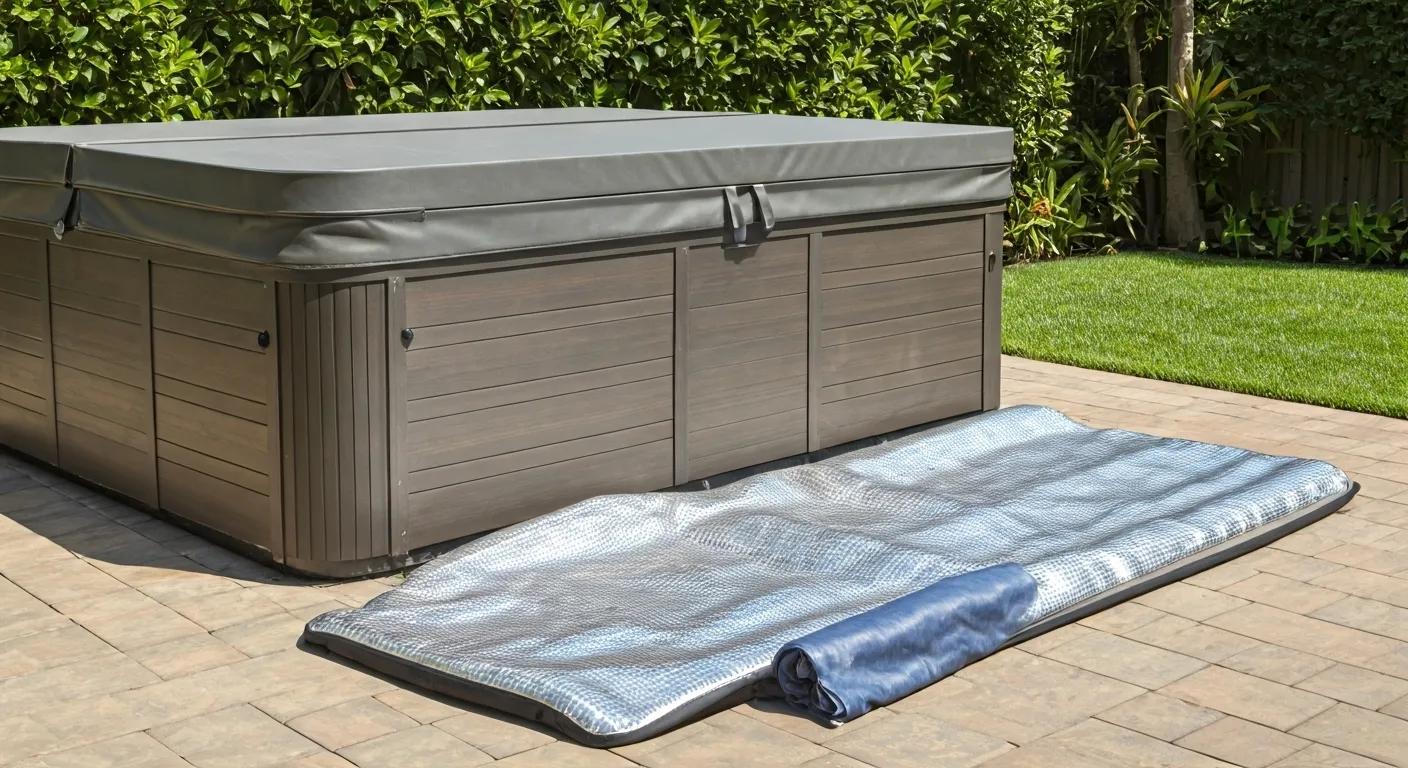Table of Contents - Enjoying Hot Tubs in the Sun: Essential Summer Care Tips!
- Ultimate Guide to Hot Tub Cover Care
- How Do UV Rays Affect Your Summer Hot Tub Cover?
- What Are the Best Methods to Protect Your Hot Tub Cover from Sun Damage?
- How Should You Clean and Maintain Your Hot Tub Cover During Summer?
- How Can You Prevent Fading and Cracking of Your Hot Tub Cover in Summer?
- How Do Chemical Balance and Water Maintenance Affect Hot Tub Cover Longevity?
- What Accessories Enhance Summer Hot Tub Cover Care and Usability?
- How Can You Maximize the Lifespan of Your Summer Hot Tub Cover?
- Conclusion
This blog post may contain affiliate links. As an Amazon Associate I earn from qualifying purchases.
Enjoying Hot Tubs in the Sun: Essential Summer Care Tips!
Ultimate Guide to Hot Tub Cover Care

Summer’s intense sunlight can degrade a hot tub cover up to 50 percent faster than cooler seasons, making proactive care essential for every hot tub owner. In this guide, I’ll show you exactly how to shield your summer hot tub cover from UV damage, keep it clean and mildew-free, prevent fading and cracking, and optimize water chemistry for lasting protection. You’ll learn:
- How UV rays, heat, and humidity impact vinyl and foam cores
- Proven sun-protection strategies, from UV sprays to cover caps
- A step-by-step cleaning and maintenance routine for hot tubs in the sun
- Early warning signs of cover damage and simple DIY repairs
- The link between balanced water chemistry and cover longevity
- Must-have accessories like cover lifters and thermal blankets
- Storage, maintenance cadence, and when replacement makes sense
Whether you’re a new hot tub enthusiast or a seasoned owner, this article from our Information Hub at OneHotTub.com will equip you to maintain a UV resistant hot tub cover that stands up to summer’s harshest conditions.
How Do UV Rays Affect Your Summer Hot Tub Cover?
Ultraviolet radiation from direct sun exposure breaks down vinyl polymers and degrades foam cores, leading to brittle, discolored, and warped spa covers that no longer insulate effectively. Understanding these sun damage mechanisms is the first step toward lasting protection.
UV Damage to Hot Tub Covers
Exposure to ultraviolet (UV) radiation from the sun is a significant factor in the degradation of hot tub covers, leading to fading, cracking, and a reduced lifespan [4, 8]. UV rays break down the vinyl polymers, causing the cover to become brittle and lose its color [4].
What Types of Sun Damage Impact Hot Tub Covers?
Summer sun can cause three main types of degradation in your spa cover: fading of the vinyl surface, cracking along seams and edges, and warping of the foam core under high heat.
Fading signals polymer breakdown, which accelerates cracking and warping when heat and humidity combine.
How Does Heat and Humidity Contribute to Cover Degradation?
Excessive heat softens the vinyl surface and expands trapped moisture in the foam core, causing blistering and core delamination. High humidity encourages mold and mildew growth under the cover’s seal and accelerates vapor-barrier failure.
Which Materials Offer the Best UV Resistance for Hot Tub Covers?
Marine-grade vinyl reinforced with UV inhibitors and a high-density foam core protected by a multi-mil vapor barrier delivers the strongest defense against sun damage.
- Marine-Grade Vinyl: Contains UV stabilizers and pigment dispersion for fade resistance.
Marine-Grade Vinyl for UV ResistanceMarine-grade vinyl, often used in hot tub covers, is treated to resist UV rays, making it more durable and longer-lasting compared to lesser-grade vinyl [1, 7]. This material contains UV stabilizers and pigment dispersion to resist fading [1].The Pros & Cons of Different Hot Tub Cover Materials – The Cover Guy - High-Density Foam: Higher R-value foam maintains shape under thermal stress.
- Multi-Mil Vapor Barrier: Prevents moisture ingress that exacerbates heat damage.
Combining these materials yields a cover that retains heat, resists sun exposure, and resists waterlogging.
What Are the Best Methods to Protect Your Hot Tub Cover from Sun Damage?

Shielding your cover from UV radiation and reflected heat can double its lifespan and sustain insulation performance. Effective strategies include applying protectants, adding physical barriers, and choosing a shaded placement.
How to Apply UV Protectants Effectively on Hot Tub Covers?
A proper application routine of vinyl protectant forms a breathable barrier that repels UV rays and moisture. Follow these steps:
- Clean the cover surface with mild soap and water to remove dirt and oils.
- Dry completely to ensure protectant adhesion.
- Spray a thin, even coat of 303 Aerospace Protectant or similar product over the vinyl surface.
- Allow 5–10 minutes for the protectant to absorb, then buff off residue with a soft cloth.
- Reapply every 4–6 weeks during peak sun exposure.
Correct application restores hydrophobic properties and blocks UV-initiated oxidation, prolonging cover flexibility and color.
What Role Do Cover Caps and Thermal Blankets Play in Sun Protection?
Adding a cover cap or thermal blanket creates an extra insulating layer that reflects UV rays, reduces surface temperature, and slows vinyl degradation.
- Cover cap: A zip-on fabric shell with UV-stable material that shields the main cover.
- Thermal blanket: A thin, closed-cell foam sheet laid between water and cover to reduce heat transfer.
Benefits of Cover Caps and Thermal Blankets
Cover caps and thermal blankets provide additional protection for hot tub covers [10, 13]. A cover cap shields the main cover from UV rays and other weather conditions, while a thermal blanket adds an extra layer of insulation [10, 13].
These accessories reduce thermal stress and protect the vinyl exterior from direct sunlight.
How Does Strategic Hot Tub Placement Reduce Sun Exposure?
Positioning your spa under shade—natural or built—dramatically lowers UV intensity and reflected heat. Consider:
- Erecting a pergola or gazebo with UV-filtering fabric
- Planting deciduous trees for seasonal shade
- Placing reflective surfaces (light-colored pavers) to minimize heat absorption
Optimal placement cuts direct sun hours by up to 70 percent, preserving cover integrity and reducing protectant reapplications.
How Should You Clean and Maintain Your Hot Tub Cover During Summer?
Regular cleaning prevents grime, mold, and chemical residues from accumulating and stressing vinyl and foam layers. A focused summer routine ensures ongoing protection against sun and moisture.
What Are the Recommended Cleaning Products for Summer Hot Tub Covers?
Gentle cleaners keep the vinyl supple without stripping protective layers. Top picks include:
- pH-neutral mild dish soap diluted in warm water
- Specialty vinyl cleaner formulated to remove oils and mildew stains
- Non-chlorinated mold and mildew treatment sprays
These products cleanse without degrading UV inhibitors or vapor barriers.
How Often Should You Clean Your Hot Tub Cover in Summer?
High sun and humidity call for a bi-weekly cleaning cycle:
- Light rinse and wipe down every two weeks
- Deep clean and conditioner application once a month
Maintaining this cadence stops mildew buildup and keeps vinyl treatable for UV protectant applications.
How to Prevent and Remove Mold and Mildew on Hot Tub Covers?
Mold spores thrive under warm, damp conditions, but simple actions eradicate and prevent growth:
- Mix equal parts water and white vinegar in a spray bottle.
- Saturate affected areas and let sit for 10 minutes.
- Scrub gently with a soft brush to lift spores.
- Rinse thoroughly and dry in shade.
- Apply vinyl conditioner to restore moisture balance.
Eradicating mildew early stops foam core damage and preserves vapor barrier performance.
How Can You Prevent Fading and Cracking of Your Hot Tub Cover in Summer?
Detecting early signs of sun damage and following consistent conditioning practices keeps your cover looking and performing like new.
What Are the Early Signs of Hot Tub Cover Fading and Cracking?
Inspect your summer hot tub cover monthly for:
- Color loss or chalky appearance on vinyl surfaces
- Small splits or wrinkles near seams and handles
- Hard, brittle spots where foam is exposed to heat
Catching these warning signs prompts quick interventions before extensive damage occurs.
Which Preventative Measures Extend Cover Durability?
Consistent conditioning routines maintain vinyl flexibility and resilience:
- Apply vinyl conditioner after each deep cleaning
- Keep the cover dry when not in use to avoid hydrolysis
- Use a cover lifter to remove strain from handles and seams
These proactive steps reinforce material properties and slow cracking.
How to Perform Minor Repairs on Sun-Damaged Covers?
Small tears and pinholes can be patched quickly to restore integrity:
Seal minor breaches promptly to prevent moisture ingress that can warp the foam core.
How Do Chemical Balance and Water Maintenance Affect Hot Tub Cover Longevity?
Imbalanced water chemistry can accelerate vinyl breakdown and cause foam discoloration, undermining both appearance and insulation.
Why Is Maintaining Proper Chemical Balance Important for Cover Health?
High or low pH and chlorine levels can etch vinyl surfaces and leach UV inhibitors. Balanced water prevents chemical off-gassing that degrades the vinyl exterior and oxidizes foam edges.
Importance of Chemical Balance
Maintaining proper chemical balance in your hot tub is crucial for the longevity of the cover [13, 15]. Imbalanced pH levels or excessive sanitizer concentrations can cause the cover to discolor, blister, and degrade prematurely. You can find more information on How To Control The pH Level of a Hot Tub by clicking the link. [15].
What Are Best Practices for Chemical Management in Summer?
- Test pH, total alkalinity, and sanitizer levels twice weekly
- Keep pH between 7.2–7.8 and chlorine at 1–3 ppm or bromine at 3–5 ppm
- Shock the spa regularly after heavy use to oxidize contaminants
It is important to regularly test your hot tub water. Stable chemistry reduces aggressive by-products that harm your cover’s materials.
What Accessories Enhance Summer Hot Tub Cover Care and Usability?
Integrating the right tools not only protects your cover but also streamlines every step of maintenance.
How Does a Cover Lifter Help Protect Your Hot Tub Cover?
A cover lifter mounts to your spa and uses leverage to remove and replace the cover without dragging it across edges. This accessory:
- Reduces handle and seam stress
- Prevents sharp-edge scuffs on vinyl
- Encourages users to replace the cover properly every time
Using a lifter extends cover life by minimizing mechanical wear.
What Are the Benefits of Using Thermal Blankets and Cover Caps?
Together, thermal blankets and cover caps:
- Provide extra R-value insulation, lowering energy costs.
- Reflect UV rays before they reach the vinyl, slowing sun damage.
- Help maintain consistent water temperature, reducing heater runtime.
These add-ons pay for themselves through energy savings and reduced protectant needs.
How Can You Maximize the Lifespan of Your Summer Hot Tub Cover?
Combining storage best practices, diligent maintenance, and timely replacements ensures you get the most out of your investment.
What Are the Best Practices for Storing Hot Tub Covers in Summer?
When your spa is not in use for extended periods:
- Dry thoroughly and stand the cover on edge in shaded storage.
- Store off-ground on a rack or hooks to prevent water pooling.
- Cover with a breathable, UV-resistant bag to block sun and pests.
Proper storage prevents waterlogging and vinyl fatigue.
How Does Regular Maintenance Translate to Investment Protection?
Consistent cleaning, conditioning, and protection cut replacement costs by up to 50 percent and preserve energy efficiency, preventing heat loss that increases operating expenses.
When Is It Time to Replace Your Hot Tub Cover Due to Sun Damage?
Even with optimal care, covers typically last 5–7 years in sunny climates. Plan a replacement when you observe:
- Extensive cracking and foam degradation
- Loss of rigidity and inability to support weight
- Persistent mildew issues despite treatment
Upgrading to a new UV resistant hot tub cover restores insulation performance and aesthetic appeal.
Summer sun can be relentless, but a proactive care plan keeps your hot tub cover performing year after year. Use this guide to integrate UV protectants, targeted cleaning routines, smart placement, and the right accessories for a durable, energy-efficient, and attractive hot tub experience all season long.
Ready to explore premium cover options and care products? Visit our collection of UV resistant hot tub covers and maintenance solutions at OneHotTub.com.
Conclusion
Proactive care for your hot tub cover not only extends its lifespan but also enhances its performance against summer’s harsh conditions. By implementing UV protectants, regular cleaning, and strategic placement, you can maintain a durable and energy-efficient cover that looks great year-round. Don’t wait for damage to occur; take action now to safeguard your investment. Explore our collection of premium UV resistant hot tub covers and maintenance solutions at OneHotTub.com.


